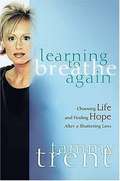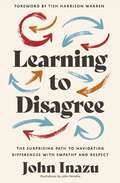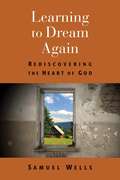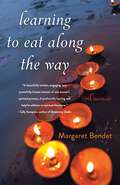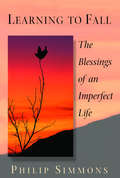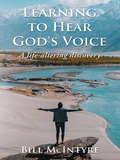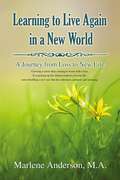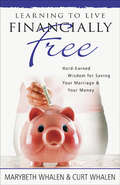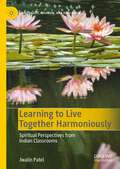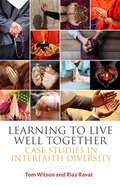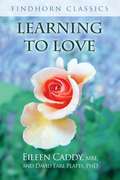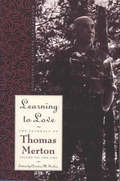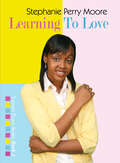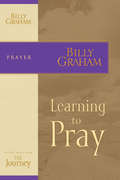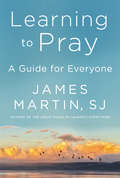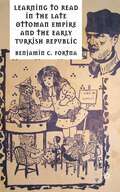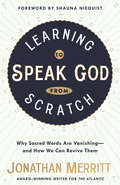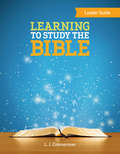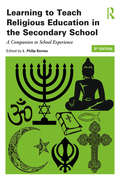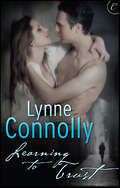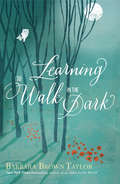- Table View
- List View
Learning to Breathe Again: Choosing life and Finding Hope After a Shattering Loss
by Tammy TrentThis is the story of one young woman who copes with the devastating loss of her best friend and husband. She points to our true help, Jesus Christ.
Learning to Disagree: The Surprising Path to Navigating Differences with Empathy and Respect
by John InazuAre you discouraged by our divided, angry culture, where even listening to a different perspective sometimes feels impossible? If so, you're not alone, and it doesn't have to be this way. Learning to Disagree reveals the surprising path to learning how to disagree in ways that build new bridges with our neighbors, coworkers, and loved ones--and help us find better ways to live joyfully in a complex society.In a tense cultural climate, is it possible to disagree productively and respectfully without compromising our convictions? Spanning a range of challenging issues--including critical race theory, sexual assault, campus protests, and clashes over religious freedom--highly regarded thought leader and law professor John Inazu helps us engage honestly and empathetically with people whose viewpoints we find strange, wrong, or even dangerous.As a constitutional scholar, legal expert, and former litigator, John has spent his career learning how to disagree well with other people. In Learning to Disagree, John shares memorable stories and draws on the practices that legal training imparts--seeing the complexity in every issue and inhabiting the mindset of an opposing point of view--to help us handle daily encounters and lifelong relationships with those who see life very differently than we do.This groundbreaking, poignant, and highly practical book equips us to:Understand what holds us back from healthy disagreementLearn specific, start-today strategies for dialoguing clearly and authenticallyMove from stuck, broken disagreements to mature, healthy disagreementsCultivate empathy as a core skill for our personal lives and our whole society If you are feeling exhausted from the tattered state of dialogue in your social media feed, around the country, and in daily conversations, you're not alone. Discover a more connected life while still maintaining the strength of your convictions through this unique, often-humorous, thought-provoking, and ultimately life-changing exploration of the best way to disagree.
Learning to Dream Again: Rediscovering the Heart of God
by Samuel WellsMeditations that beautifully articulate a contemporary Christian wisdomThrough a series of short, thoughtful meditations, Learning to Dream Again shows what true wisdom -- wisdom shaped by Jesus' earthy humility, shameful suffering, and effervescent joy -- might look like for Christians today. Through the lens of this Christian wisdom, Samuel Wells addresses a number of difficult personal and social issues, including taxes, abortion, torture, hunger, and Christian engagement with broader culture in the arts, sciences, athletics, and medicine.As he seeks to present a faithful rendering of the mind of Christ, Wells deftly ties abstract ideas to everyday Christian living. He groups his meditations thematically into these six chapters:Learning to Love AgainLearning to Live AgainLearning to Think AgainLearning to Read AgainLearning to Feel AgainLearning to Dream AgainBeautifully written and extraordinarily insightful, Learning to Dream Again is both for Christians who have been to church for years but long to ponder the ambiguities and hard questions of faith and life and for new Christians who are just beginning to investigate how the gospel connects to their most searching questions.
Learning to Eat Along the Way: A Memoir
by Margaret BendetWhen Margaret Bendet is told to interview an Indian holy man, she thinks it&’s just another assignment—but after speaking with him, she decides to accompany him back to his ashram, hoping to find enlightenment. In Learning to Eat Along the Way, Bendet enters a world that many have wondered about but few have seen: the milieu of a spiritual master. Subtle experiences prompt her to embark on this journey with &“the swami,&” as she calls the holy man, and to enter into the ashram—but once there, she deals with a host of psychological issues, including intense infatuation and life-threatening anorexia. &“Each person comes to the ashram in order to receive something,&” the swami tells her, &“something to take with you when you leave—something you can eat along the way.&” Bendet finds this to be truer than she could have imagined. Clear-eyed and candid, Learning to Eat Along the Way is an honest and often surprising account of one woman&’s experience with spiritual work.
Learning to Fall: The Blessings of an Imperfect Life
by Philip SimmonsA &“reflective, eloquent [and] inspiringly written&” (The New York Times) collection of essays about learning to live richly in the face of loss &“Astonishing . . . sometimes heartbreaking . . . sometimes hilarious.&”—The Boston Globe WINNER OF THE BOOKS FOR A BETTER LIFE AWARD&’S BEST SPIRITUAL BOOKPhilip Simmons was just thirty-five years old in 1993 when he learned that he had ALS, or Lou Gehrig&’s disease, and was told he had less than five years to live. As a young husband and father, and at the start of a promising literary career, he suddenly had to learn the art of dying. Nine years later, he succeeded, against the odds, in learning the art of living. In this surprisingly joyous and spirit-renewing book, he chronicles his search for peace and his deepening relationship with the mystery of everyday life. From our first faltering steps, Simmons says, we may fall into disappointment or grief, fall into or out of love, fall from youth or health. And though we have little choice as to the timing or means of our descent, we may, as he affirms, &“fall with grace, to grace.&”With humor, hard-earned wisdom, and a keen eye for life&’s lessons—whether drawn from great poetry or visits to the town dump—Simmons shares his discovery that even at times of great sorrow we may find profound freedom. And by sharing the wonder of his daily life, he offers us the gift of connecting more deeply and joyously with our own.
Learning To Hear God's Voice: A Life-Altering Discovery
by Bill McIntyreHave you ever heard someone say, “God lead me to do _____” or “God said _____ to me?” Did you wonder, “Is he some kind of spiritual giant or is his bubble just a little off center?” Author Bill McIntyre shares true stories of his personal journey, from a childhood plan for murder, to hiking through jungles sharing the Gospel in remote African villages. Bill relays testimonies and examples of God’s miraculous workings in his life to demonstrate how to hear and understand the voice of the Holy Spirit. In these pages you will discover sound Scriptural teachings on hearing the voice of God. This is not a book that says, “Try harder to become more sinless. Follow all the church’s religious rules.” It doesn’t say, “If you were just a better person God might talk to you, too.” Finally, here is a book of practical advice on how to train your spirit to hear God and how to recognize His voice when He speaks. God desires to talk to you. Are you ready to learn how to listen? “Bill’s life stories are for people like me who benefit from knowing others have faced difficulties and circumstances never taught in school and far from theoretical. You will learn much from reading Bill’s experiences and from his practical application of God’s Word. This is a book unlike any other you have ever read.” Ric Shields President/Founder of DoorWays®
Learning to Live Again in a New World: A Journey from Loss to New Life
by Marlene AndersonLoss brings with it many layers of grief that need to be addressed. Healing from losses requires more than just talking about our pain; it involves working through the twists and turns of conflicting emotions and confronting questions that often have no satisfactory answers. It is reassembling the pieces of life that have been shattered by assumptions and expectations in order to create a new beginning. Within the process we begin to heal and recover. But as we close one chapter of life, we need tools and information to begin a new chapter and make that transition from what was to what is now. It requires challenging old assumptions and creating a new identity and road map for life going forward.
Learning to Live Financially Free: Hard-Earned Wisdom for Saving Your Marriage & Your Money
by Curt Whalen Marybeth WhalenA personal look at what it takes to live debt freeIn this timely new book based on their own financial challenges, Marybeth Whalen and Curt Whalen offer hard-earned wisdom and hope to families who struggle with debt and the consequences of financial mistakes. The Whalens draw from their own experiences of their first ten years of marriage to create a resource that provides both a helpful hand and a hopeful word for couples who need to get and keep their finances in order and nurture their marriage at the same time.
Learning to Live Together Harmoniously: Spiritual Perspectives from Indian Classrooms (Spirituality, Religion, and Education)
by Jwalin PatelThis book calls for an expanded vision of holistic education that emphasizes togetherness and harmony through the discovery of oneself, others, and the larger society. It brings together teachers’ voices, experiences, and practices for such an education with Southern Knowledge, philosophy and ideologies proposed by Indian philosophers and spiritual leaders like Aurobindo, the Dalai Lama, Gandhi, Krishnamurti, and Tagore. The book reconceptualizes and extends UNESCO's "Learning To Live Together" to emphasize "Learning to Live Together Harmoniously" (LTLTH) and develops a novel conceptual framework for it. The book also explores how LTLTH can be translated into practice; calling for a continuum of harmonious lived experiences created through experiential and project based pedagogy, systems and processes for autonomy and autonomous behaviour regulation, empathetic teacher student relations, schoolwide ethos of harmonious living, and teachers’ ways of living and being.
Learning to Live Well Together: Case Studies in Interfaith Diversity
by Tom Wilson Riaz RavatIn modern multi-faith societies, religious diversity not only affects religious organisations and communities, but indeed every aspect of life. From celebrating cultural events, to considering how the police should interact with members of the public from different faith communities, this book highlights the ways in which all members of society can engage constructively with diversity. This ground-breaking book draws on the work at the St Philip's Centre in Leicester and presents a collection of case studies to show how people from a variety of religious backgrounds and ethical convictions have learnt to coexist peacefully. Without shying away from the conflicts and challenges that have occurred, the book focuses on the lessons learnt and offers real examples of how to promote positive interfaith relationships. This is an excellent resource for anyone wishing to understand the issues of religion and belief that may arise at local and national levels, and develop appropriate attitudes and actions for peaceful resolution.
Learning to Love
by Eileen Caddy David Earl PlattsAn insightful guide for consciously bringing compassion and love into your life • Explores feelings, attitudes, beliefs, and past experiences that block us from loving and receiving love • Includes deceptively simple yet profound exercises, meditations, and visualizations to support the exploration of your inner world • Explains how these principles and techniques originated in Roberto Assagioli’s system of psychosynthesis, enriched by the Findhorn experience of living in community Every person is born with the capacity to love. Over time, however, many of us have built barriers within ourselves as a reaction to painful experiences, and following these, we often develop fears, beliefs, and behaviors that keep these barriers firmly in place. The primary lesson in life is to learn to love, and this starts right on our doorstep. Often it is self-doubt and feelings of unworthiness that hold us back from experiencing all the love around us. Only when we start to love and accept ourselves with all that we are can we love others freely and fully. Learning to love requires an intention to change and a willingness to take action. Once we understand how to work with our doubts and fears and learn how to change our beliefs and behavior, our barriers will melt away and we spontaneously open up to connect deeply and harmoniously with the full flow of the river of life. In this simple yet insightful guide, Eileen Caddy and David Earl Platts detail the down-to-earth practicalities of exploring feelings, attitudes, beliefs, and past experiences that block us from loving and from receiving love. They show how bringing more love into our lives is not a mystery but often a journey back to ourselves and our core values. The authors examine the feelings of acceptance, trust, forgiveness, respect, opening up, and taking risks, among others, within a framework of compassionate understanding and non-judgment. Deceptively simple yet profound exercises, meditations, and visualizations support the reader in examining their inner world and implementing these vital concepts into their lives. The teachings in the book are based on popular workshops that Eileen, co-founder of the Findhorn Foundation Community, and David facilitated for years in and outside Findhorn. Many of the underlying principles and techniques originate in the system of psychosynthesis, devised by Roberto Assagioli. Learning to Love invites you to make a free and informed choice to bring more love into your life, and then helps you implement this choice step-by-step with confidence and joy.
Learning To Love
by Thomas MertonHaving embraced a life of solitude in his own hermitage, Thomas Merton finds his faith tested beyond his imagination when a visit to the hospital leads to a clandestine affair of the heart. Jolted out of his comfortable routine, Merton is forced to reassess his need for love and his commitment to celibacy and the monastic vocation. This astonishing volume traces Merton's struggle to reconcile his unexpected love with his sacred vows while continuing to grapple with the burning social issues of the day--including racial conflicts, the war in Vietnam, and the Arab-Israeli conflict--visiting and corresponding with high-profile friends like Thich Nhat Hanh and Joan Baez, and further developing his writing career. Revealing Merton to be 'very human' in his chronicles of the ecstasy and torment of being in love, Learning to Love comes full circle as Merton recommits himself completely and more deeply to his vocation even as he recognizes 'my need for love, my loneliness, my inner division, the struggle in which solitude is at once a problem and a 'solution'. And perhaps not a perfect solution either' (11 May, 1967).
Learning To Love
by Thomas MertonHaving embraced a life of solitude in his own hermitage, Thomas Merton finds his faith tested beyond his imagination when a visit to the hospital leads to a clandestine affair of the heart. Jolted out of his comfortable routine, Merton is forced to reassess his need for love and his commitment to celibacy and the monastic vocation. This astonishing volume traces Merton's struggle to reconcile his unexpected love with his sacred vows while continuing to grapple with the burning social issues of the day--including racial conflicts, the war in Vietnam, and the Arab-Israeli conflict--visiting and corresponding with high-profile friends like Thich Nhat Hanh and Joan Baez, and further developing his writing career. Revealing Merton to be 'very human' in his chronicles of the ecstasy and torment of being in love, Learning to Love comes full circle as Merton recommits himself completely and more deeply to his vocation even as he recognizes 'my need for love, my loneliness, my inner division, the struggle in which solitude is at once a problem and a 'solution'. And perhaps not a perfect solution either' (11 May, 1967).
Learning to Love (Yasmin Peace Series #4)
by Stephanie Perry MooreYasmin Peace has been through a lot in the last year. After losing their oldest brother and son, Yasmin, her brothers and mother lose their apartment in a fire. As if that was not enough, Yasmin's grandmother is diagnosed with Alzheimers. Through all of these seemingly bad situations, Yasmin does not lose hope that things will get better. As she heads off to high school, that hope pays off and things are finally starting to look up. She has three great friends, her father is out of jail and finally, the drama is behind her. At least that's what Yasmin thinks. She has yet to learn the lessons of love as she finds out that loving those who are the closest to her is not always an easy thing to do.
Learning to Love (Yasmin Peace Series #4)
by Stephanie Perry MooreYasmin Peace has been through a lot in the last year. After losing their oldest brother and son, Yasmin, her brothers and mother lose their apartment in a fire. As if that was not enough, Yasmin's grandmother is diagnosed with Alzheimers. Through all of these seemingly bad situations, Yasmin does not lose hope that things will get better. As she heads off to high school, that hope pays off and things are finally starting to look up. She has three great friends, her father is out of jail and finally, the drama is behind her. At least that's what Yasmin thinks. She has yet to learn the lessons of love as she finds out that loving those who are the closest to her is not always an easy thing to do.
Learning to Pray: The Journey Study Series
by Billy Graham"You will only make this journey once. What kind of journey will it be?" Is prayer really that important? Doesn't God know what we need? Do you look forward to praying-or dread it? It is never a mistake to pray, but we do need to understand fully what prayer is and its role in our lives.Learning to Pray looks at the incredible privilege we have of speaking directly with our Creator at any time. God wants to be in fellowship with us. Learn to speak to God through prayer, offer him praise and thanksgiving, and listen for an answer. Talk to God and get to know Him better as you journey on life's path.The Journey Study Series is based on Billy Graham's best-selling book The journey, the culmination of lifetime of spiritual insight and ministry experience. Each chapter explores the joys, triumphs, and conflicts we all encounter on our journey through life. Use for self-study or shared experiences in small groups, six weeks of lessons, sidebars offer a scriptural journey through God's word, questions for starting group discussions, insight-filled scripture passages to study. Each chapter includes thought-provoking questions, commentary, Scriptures, and insights to help you on life's journey. Each lesson teaches the secret of walking with God on life's path. Understanding God's truths will make life's journey easier and let Him fulfill His promise to lead you home.
Learning to Pray: A Guide for Everyone
by James MartinOne of America’s most beloved spiritual leaders and the New York Times bestselling author of The Jesuit Guide to (Almost) Everything and Jesus: A Pilgrimage teaches anyone to converse with God in this comprehensive guide to prayer.In The Jesuit Guide to (Almost) Everything, Father James Martin included a chapter on communicating with God. Now, he expands those thoughts in this profound and practical handbook. Learning to Pray explains what prayer is, what to expect from praying, how to do it, and how it can transform us when we make it a regular practice in our lives. A trusted guide walking beside us as we navigate our unique spiritual paths, Martin lays out the different styles and traditions of prayer throughout Christian history and invites us to experiment and discover which works best to feed our soul and build intimacy with our Creator. Father Martin makes clear there is not one secret formula for praying. But like any relationship, each person can discover the best style for building an intimate relationship with God, regardless of religion or denomination. Prayer, he teaches us, is open and accessible to anyone willing to open their heart.
Learning to Read in the Late Ottoman Empire and the Early Turkish Republic
by Benjamin C. FortnaAn exploration of the ways in which children learned and were taught to read, against the background of the transition from Ottoman Empire to Turkish Republic. This study gives us a fresh perspective on the transition from empire to republic by showing us the ways that reading was central to the construction of modernity.
Learning to Speak God from Scratch: Why Sacred Words Are Vanishing--and How We Can Revive Them
by Jonathan Merritt Shauna NiequistIn a rapidly changing culture, many of us struggle to talk about faith. We can no longer assume our friends understand words such as grace or gospel. Others, like lost and sin, have become so negative they are nearly conversation-enders. Jonathan Merritt knows this frustration well. After moving from the Bible Belt to New York City, he discovered that the sacred terms he used to describe his spiritual life didn’t connect as they had in the past. This launched him into an exploration of an increasing American reluctance to talk about faith—and the data he uncovered revealed a quiet crisis of affecting millions. In this groundbreaking book, Jonathan revives ancient expressions through incisive cultural commentary, vulnerable personal narratives, and surprising biblical insights. Both provocative and liberating, Learning to Speak God from Scratch will breathe new life into your spiritual conversations and invite you into the embrace of the God who inhabits them.
Learning to Study the Bible Leader Guide: For Tweens
by L. J. ZimmermanLearning to Study the Bible guides your tween students through eight weeks of Bible discovery. They’ll explore the wonders of biblical geography and archaeology. They’ll compare and contrast biblical genres. They’ll learn the history of biblical interpretation, and discover that they are Bible interpreters too! Students will become familiar with Bible dictionaries, commentaries, concordances, maps, and more. Best of all, they’ll practice sharing their Bible knowledge with others each week. Session Outline and Learning Goals: 1. Who? * Learn to identify the original author and audience * Understand your own social location and biases * Practice reading a text with the author and original audience in mind 2. What? * Understand the significance of genre * Practice identifying genre in biblical texts 3. When? * Understand the significance of historical context * Learn about the major social contexts of biblical texts * Practice reading Scripture contextually 4. Where? * Learn how to utilize biblical maps * Understand the significance of geography and shifting national borders for biblical interpretation * Practice interpreting a biblical text with a geographical lens 5. Why? * Learn about the formation of the canon * Understand the significance of a text’s changing meaning over time * Practice reading a text with multiple layers of meaning 6. How? Close reading * Learn the value of reading texts slowly and carefully * Understand how to use study bibles and commentaries * Practice reading a short text carefully 7. How? Side-by-side reading * Learn about the Revised Common Lectionary and its purpose * Understand how to use a concordance to cross-reference texts * Practice reading a text intra-canonically 8. How? Lectio Divina * Learn about the ancient practice of Lectio Divina * Understand the significance of a spiritual reading of Scripture * Practice Lectio Divina individually and as a group 1. Who? * Learn to identify the original author and audience * Understand your own social location and biases * Practice reading a text with the author and original audience in mind 2. What? * Understand the significance of genre * Practice identifying genre in biblical texts 3. When? * Understand the significance of historical context * Learn about the major social contexts of biblical texts * Practice reading Scripture contextually 4. Where? * Learn how to utilize biblical maps * Understand the significance of geography and shifting national borders for biblical interpretation * Practice interpreting a biblical text with a geographical lens 5. Why? * Learn about the formation of the canon * Understand the significance of a text’s changing meaning over time * Practice reading a text with multiple layers of meaning 6. How? Close reading * Learn the value of reading texts slowly and carefully * Understand how to use study bibles and commentaries * Practice reading a short text carefully 7. How? Side-by-side reading * Learn about the Revised Common Lectionary and its purpose * Understand how to use a concordance to cross-reference texts * Practice reading a text intra-canonically 8. How? Lectio Divina * Learn about the ancient practice of Lectio Divina * Understand the significance of a spiritual reading of Scripture * Practice Lectio Divina individually and as a group
Learning to Study the Bible Leader Guide
by L. J. ZimmermanLearning to Study the Bible is an eight-week study for adults, exploring the biblical history and methods of interpretations using the classic questions: Who? What? When? Where? Why? and How? This study explores geography, archeology, biblical genre, context, and interpretation. Participants will also learn how to use important biblical resources such as Bible dictionaries, commentaries, concordances, and more. The goal of Learning To Study the Bible is to equip participants to read and study the Bible for themselves. It seeks to deepens one's understanding of the biblical stories and to help participants grow in their biblical faith. Tween version of this resource is also available. Session Outline and Learning Goals: Who? Author and Audience Learn about the authors and original audiences of the Bible Use a Bible dictionary Sharpen deductive reasoning skills in biblical interpretation What? Genre Introduce and explore biblical genres Learn to use Bible commentaries and apps to identify possible genres of texts Explore the significance of genre for biblical interpretation When? Context Investigate the connection between context and meaning Spark curiosity about biblical and modern cultural contexts Use Bible dictionaries, commentaries, and handbooks to research biblical context Where? Geography Spark curiosity about the biblical landscape Prompt reflection on the relationship between land and daily life Use biblical maps and archaeological research to explore biblical geography Why? Interpretation Create awareness of interpretive lenses and layers Spark curiosity about our own and others’ interpretive lenses Use a concordance and various translations to compare meanings How? Read Closely Cultivate appreciation for the way our ancestors preserved the biblical text Practice reading carefully and paying attention Discover the four meanings of Scripture and practice interpreting them How? Reread Create awareness of our own role in making meaning Prompt reflection on the nature of Scripture as the “living word of God” Practice the ancient tradition of divine reading How? Read Together Create awareness of the diversity of voices within the canon Inspire students to enter into the centuries-long biblical conversation Practice reading the Bible inter-canonically
Learning to Teach Religious Education in the Secondary School: A Companion to School Experience (Learning to Teach Subjects in the Secondary School Series)
by Edited by L. Philip BarnesThe third edition of Learning to Teach Religious Education in the Secondary School draws together insights from current educational theory and the best contemporary classroom teaching and learning, and suggests tasks, activities and further reading designed to enhance the quality of initial school experience for the student teacher. This third edition has all new content and contributors, which take account of recent developments in the subject. Key themes addressed include: the aims and place of religious education in the curriculum; recent policy developments; developing lesson plans and schemes of work; the role of language and talk in religious education; spirituality and spiritual development; assessment in religious education; religious education at both Key Stage 4 and at A Level; religion education in relation to moral education; the role of computers; inclusion; professional development. Learning to Teach Religious Education in the Secondary School is designed to provide student teachers with a comprehensive and accessible introduction to teaching religious education in the secondary school.
Learning to Think: A Memoir of Faith, Superstition, and the Courage to Ask Questions
by Tracy KingSet in 1980s Birmingham, England, a piercing memoir about the liberating power of a scientific view of the world. Tracy King was raised in a house of contradictions—her family was happy and creative, yet shadowed by debt, phobias, her father’s alcoholism, and the illusory promises of a born-again Christian church. The uneasy balance of the King household was irrevocably upended on a rainy spring night in 1988, when her father was killed by teenagers just blocks from their public housing estate. Her mother’s dysfunctional reliance on the church deepened following the tragedy, and King, suffering from undiagnosed anxiety, stopped attending school. The account of her father’s death remained hazy, made worse by the fact that four of the accused teenagers—neighborhood boys she could not avoid—were never charged. What could have triggered such an act of aggression? Clinging to hearsay and what little information she had from the police, King allowed her imagination to fill in the rest. Over the years, in a bid to balm her grief and gaps in formal education, King journeyed through multiple belief systems: she distanced herself from fundamentalism, searching for clarity instead in the occult, paranormal beliefs, and conspiracy theories. Amid the chaos of her coming of age, she stumbled upon a copy of Carl Sagan’s The Demon-Haunted World on the shelves of a Birmingham bookshop —a discovery that proved transformative. Sagan’s sage caveat, “But I could be wrong,” became King’s guiding light, empowering her to confront her demons. An eloquently written and often sharply funny account that is ever sensitive to the fallibility of memory and the nuances of truth, Learning to Think is a resounding battle cry for the value of education and the freedom to think critically, imaginatively, and for oneself.
Learning to Trust
by Lynne ConnollySocialite Bellina Mazzanti Forde was the ultimate party girl-until she disappeared with Byron Brantley five years ago. Determined to find his brother, Jonathan Brantley has tracked Lina to a café in Naples and demands answers. Certain she's hiding something, Jonathan vows not to let Lina out of his sight until she agrees to help him, even if it takes all night. Though he doesn't trust her, he can't deny that he wants her-has always wanted her...Happy in her new, simpler life, Lina didn't want to be found. Now that the past has caught up with her in the form of the sexy tycoon, she's torn between exploring the passion he arouses in her, and facing the secrets that caused her to flee New York. The tension between them soon leads to a scorching affair, one they both know can't last. But when their search for Byron finds them tangling with the mob, Jon and Lina learn they have no one to trust but each other...73,000 words
Learning to Walk in the Dark: Because God Often Shows Up At Night
by Barbara Brown TaylorFollow Barbara Brown Taylor on her journey to understand darkness, which takes her spelunking in unlit caves, learning to eat and cross the street as a blind person, discovering how "dark emotions" are prevented from seeing light from a psychiatrist, and rereading scripture to see all the times God shows up at night. With her characteristic charm and wisdom, Taylor is our guide through a spirituality of the nighttime, teaching us how to find God even in darkness, and giving us a way to let darkness teach us what we need to know.de through a spirituality of the nighttime, teaching us how to find our footing in times of uncertainty and giving us strength and hope to face all of life's challenging moments.
